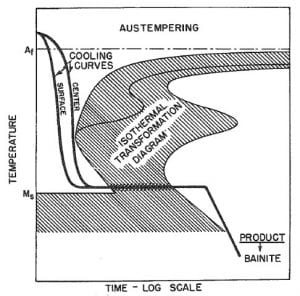CHTE Researchers Explore New Ways to Enhance the Austempering Process for Steels
In the 1920’s, Edgar Collins Bain, an American metallurgist and member of the National Academy of Sciences, along with his colleague E.S. Davenport, discovered a microstructure that forms in steels at temperatures of 250–550 °C. While it resembled martensite in outward appearance, it was actually quite different. In Bain’s honor, this newly identified microstructure was named bainite.
Today, bainite is used in a wide variety of critical material applications – military, railway, automotive – but there is growing pressure to find new ways to enhance performance of the microstructure, while perfecting the cooling process. That is critical since the preferred, current cooling method of salt bath quenching is raising environmental questions.
The Center for Heat Treating Excellence (CHTE) at Worcester Polytechnic Institute (WPI) in Worcester, Mass. is currently conducting a three-year research project that will help the heat treat industry better understand process parameters related to austempering of steels. The research will help the industry better understand the potential strength, toughness and cost benefits of bainitic steels over martensitic steels. And it will provide furnace manufacturers and commercial heat treat shops with knowledge and experience in the design, validation and control of heat treating processes designed to produce bainitic microstructures in steels.
As shown in this time-temperature diagram, austempering involves heating to above austenitizing temperature, cooling to just above Ms temperature, holding at that temperature until the transformation is complete and then cooling further to room temperature. Source: Vander Voort, George F., ed. Atlas of time-temperature diagrams for irons and steels. ASM international, 1991.
Research Objectives
Under the direction of Richard Sisson, George F. Fuller Professor of Mechanical Engineering at WPI, and director of CHTE, this research project aims to answer the following questions:
• How bainite can be formed without quenching in liquid salt, which is currently raising environmental concerns?
• What alternative quenching media can be used?
• How can cooling rates be optimized and controlled?
• What temperature should the part be held at and for how long to provide the desired properties?
According to Sisson, “We are looking into alternative quenching media, other than liquid salt, that can be used in the cooling process and still maintain strength, ductility and toughness of the heat treated part. And we are exploring how precisely we need to hold the temperature; what’s the range that we can live with?”
The belief is that others have attempted to do this type of research, but to date the results are proprietary and the data isn’t being shared. “This is an opportunity for CHTE to provide necessary answers to our members on a subject of critical importance,” said Mei Yang, assistant research professor at WPI and associate technical director of CHTE.
At this time, CHTE researchers expect to conduct austempering experiments to determine the bainite transformation kinetics by:
- Heating to a temperature within the austenitizing range.
- Quenching in salt bath/fluidized bed and maintaining at a constant temperature (bainite transformation temperature).
- Holding for a time to allow transformation to a bainite microstructure.
- Cooling to room temperature.
- Characterizing the austempered samples to investigate the bainite transformation kinetics.
If you would like to know more about CHTE and the valuable work that it is doing for the heat treating industry, please contact Rick Sisson at: sisson@wpi.edu.


